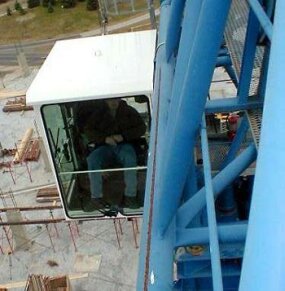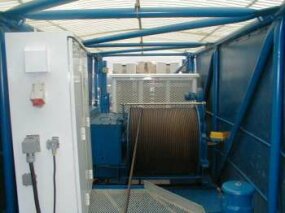Today constructing a high rise building or structure would not be possible if without a Tower Cranes. It is driven or operated by a professional or highly trained crane operator. The operator must be alert or must be exact on what he is doing because just one false moved by him it will be disaster. The tower Crane might collapsed or might bang on the building or the structure as he moves around.
Tower cranes are a common fixture at any major construction site. They're pretty hard to miss -- they often rise hundreds of feet into the air, and can reach out just as far. The construction crew uses the tower crane to lift Steel, concrete, large tools like acetylene torches and generators, and a wide variety of other building materials.
When you look at one of these cranes, what it can do seems nearly impossible: Why doesn't it tip over? How can such a long boom lift so much weight? How is it able to grow taller as the building grows taller? If you have ever wondered about how tower cranes work, then this article is for you. In this article, you'll find out the answers to all of these questions and more!
This Tower Cranes are used to transport materials from the ground to the top most part of the building constructed or as needed to the floors constructed. This cranes made the materials transporting easier for the construction.
Parts of a Tower Crane
All tower cranes consist of the same basic parts:
- The base is bolted to a large concrete pad that supports the crane.
- The base connects to the mast (or tower), which gives the tower crane its height.
- Attached to the top of the mast is the slewing unit -- the gear and motor -- that allows the crane to rotate:
On top of the slewing unit are three parts:
- The long horizontal jib (or working arm), which is the portion of the crane that carries the load. A trolley runs along the jib to move the load in and out from the crane's center
- The shorter horizontal machinery arm, which contains the crane's motors and electronics as well as the large concrete counter weights
The machinery arm contains the motor that lifts the load, along with the control electronics that drive it and the cable drum, as shown here:
The motors that drive the slewing unit are located above the unit's large gear.
A typical tower crane has the following specifications:
- Maximum unsupported height - 265 feet (80 meters) The crane can have a total height much greater than 265 feet if it is tied into the building as the building rises around the crane.
- Maximum reach - 230 feet (70 meters)
- Maximum lifting power - 19.8 tons (18 metric tons), 300 tonne-meters (metric ton = tonne)
- Counterweights - 20 tons (16.3 metric tons)
The maximum load that the crane can lift is 18 metric tons (39,690 pounds), but the crane cannot lift that much weight if the load is positioned at the end of the jib. The closer the load is positioned to the mast, the more weight the crane can lift safely. The 300 tonne-meter rating tells you the relationship. For example, if the operator positions the load 30 meters (100 feet) from the mast, the crane can lift a maximum of 10.1 tonnes.








thanks for sharing informative content on cranes. i like the way you express each point,
ReplyDeleteCranes are very useful equipment for my construction Sites, thanks for sharing this infromation, it will help me to choose the right crane rental service
ReplyDeleteWow, this blog on Tower Cranes at Work is incredibly fascinating and informative! Tower cranes are truly remarkable machines that play a vital role in the construction industry. The author does an excellent job of explaining their functionality, highlighting their immense lifting capabilities, and showcasing their importance in high-rise building projects. To know more about the same Visit the link - https://www.boomandbucket.com/equipment/cranes
ReplyDeleteWow, this blog about Tower Cranes in Action is absolutely captivating and educational! Tower cranes are undeniably extraordinary machines that hold a crucial position within the construction sector. The author skillfully elucidates their operations, emphasizing their impressive lifting capacities and underscoring their significance in tall building projects.
ReplyDeleteThank you Cássio Cunha Lima
I just wanted to drop by and say thank you for your consistent high-quality content. It's clear that you put a lot of effort into your blog, and it doesn't go unnoticed.Sidney De Queiroz Pedrosa
ReplyDeleteI wanted to take a moment to express my gratitude for the consistently excellent content you provide. Your dedication and effort in maintaining the quality of your blog are truly commendable, and it certainly does not go unnoticed. Beatriz Barata
ReplyDeleteNyc read! I've always been fascinated by the engineering behind tower cranes. They're like the giants of the construction world, effortlessly lifting heavy loads and shaping our skylines. It's amazing to see how they work, and this article provided a nice glimpse into their functionality. Thanks for sharing! To know more click here
ReplyDeleteWow, these tower cranes are incredible! It's amazing to see how they effortlessly lift and move those heavy materials with such precision. The skill of the operators must be top-notch. Thanks for sharing! 🏗️💪👷♂️ To know more click here
ReplyDeleteWonderful blog! I've always been interested in the engineering underlying tower cranes. They're like construction titans, easily lifting big loads and creating our skylines. It's fascinating to see how they work, and this article provided an excellent overview of their capabilities. Thank you for sharing! Click here to learn more.
ReplyDeleteI wanted to convey my appreciation for the continually wonderful information you supply. Your passion and work in maintaining the quality of your blog are genuinely admirable, and they do not go unnoticed. Visit here
ReplyDeleteGreat post! Tower cranes play such a crucial role in construction, offering impressive height and precision to complete large-scale projects. Their ability to lift heavy materials with ease showcases the power and efficiency of modern engineering. Thanks for sharing these insights!THEJEMBE
ReplyDelete